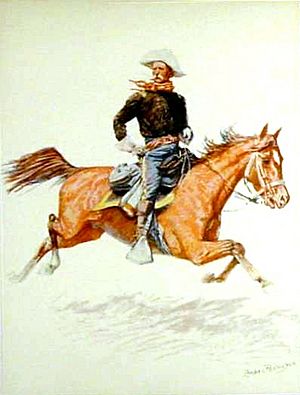Battle of Big Dry Wash facts for kids
Quick facts for kids Battle of Big Dry Wash |
|||||||
|---|---|---|---|---|---|---|---|
| Part of Apache Wars | |||||||
 A U.S. cavalry officer |
|||||||
|
|||||||
| Belligerents | |||||||
| Apache | |||||||
| Commanders and leaders | |||||||
| Na-tio-tish† | |||||||
| Strength | |||||||
| ~60 warriors | 350 cavalry | ||||||
| Casualties and losses | |||||||
| 20 killed | 2 killed 6 wounded |
||||||
The Battle of Big Dry Wash was a fight that took place on July 17, 1882. It was between soldiers from the United States Army and members of the White Mountain Apache tribe. The battle happened in a place called "Big Dry Wash." This name was used in official reports. Later maps sometimes called it "Big Dry Fork." This battle is important because four soldiers received the Medal of Honor for their bravery here.
Contents
Why the Battle Happened
In the spring of 1882, a group of about 60 White Mountain Apache warriors came together. Their leader was a warrior named Na-tio-tish. In early July, some of these warriors attacked and killed several policemen from San Carlos. After this event, Na-tio-tish led his group northwest. They traveled through an area known as the Tonto Basin.
People living in Arizona were very worried. They asked the army for help and protection. The army quickly sent out many cavalry troops from nearby forts.
Apache Plans and Army Scouts
In the middle of July, Na-tio-tish led his group up Cherry Creek. They were heading towards the Mogollon Rim. Their goal was to reach General Springs, a well-known water hole. The Apaches noticed that a single group of cavalry was following them. So, they decided to set a trap.
They chose a spot seven miles north of General Springs. Here, a part of East Clear Creek cuts a deep gorge into the Mogollon Rim. The Apaches hid on the far side of this gorge and waited.
The cavalry company was led by Captain Adna R. Chaffee. However, Captain Chaffee's main scout, Al Sieber, was very skilled. He discovered the Apaches' trap before the soldiers rode into it. He quickly warned the troops. During the night, Captain Chaffee's company received help. Four more companies arrived from Fort Apache. These new troops were led by Major Andrew W. Evans. Another person present was Britton Davis, who later wrote about the battle.
The Battle Begins
The fighting started early on the morning of July 17. One company of cavalry began shooting from the rim, facing the Apaches. At the same time, Captain Chaffee sent two companies upstream and two downstream. Their mission was to sneak across the canyon. They planned to attack the Apaches from different sides.
Na-tio-tish had not placed lookouts, so the soldiers crossed the canyon without being seen. Many Apache warriors were killed, including their leader, Na-tio-tish. On the ridge above the wash, Lieutenant George H. Morgan led the first big part of the battle. He was hit by a bullet that went through his arm and into his body.
Brave Actions During the Fight
About two hours into the battle, Lieutenant Thomas Cruse saw an Apache camp. It looked empty. He took four men and quickly ran across the ravine to capture the camp. When they reached the spot, some hidden warriors fired at them. Private Joseph McLarnon, who was right next to Cruse, was seriously injured. Cruse bravely pulled Private McLarnon back to safety.
As the battle got more intense, Lieutenant Frank West took charge of Captain Chaffee's cavalry troop. This happened while Chaffee was busy directing the overall battle. The first shots were fired around 3:00 PM. The battle continued until nightfall. Then, a strong thunderstorm hit, bringing heavy rain and hail. Scout Al Sieber, along with fellow scout Tom Horn and Lieutenant George H. Morgan, moved to the banks opposite the Apache line. They provided rifle fire to support the cavalry.
After the Battle
The remaining Apache warriors were under pressure and outnumbered. They used the darkness and the storm to slip away quietly. They retreated on foot to a nearby Apache reservation, about 20 miles away. Today, the place where the battle happened is a historical park. It is located in Coconino County, Arizona.
Recognizing Bravery
Four men received the Medal of Honor for their brave actions in this battle. They were Thomas Cruse, George H. Morgan, Charles Taylor, and Frank West. Cruse, Morgan, and West were all Lieutenants. They had also graduated from West Point, a famous military school. Taylor was a career soldier and a First Sergeant at the time of the battle.
This battle was the last major fight between the United States Army and Apache warriors. However, the Apache Wars were not completely over yet. The U.S. army soon began the Geronimo Campaign. This campaign ended when Geronimo was captured in 1886. Even after that, some Apache attacks on settlers in Arizona continued until around the year 1900.

